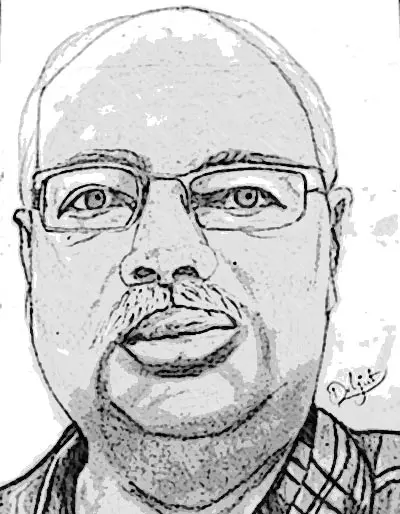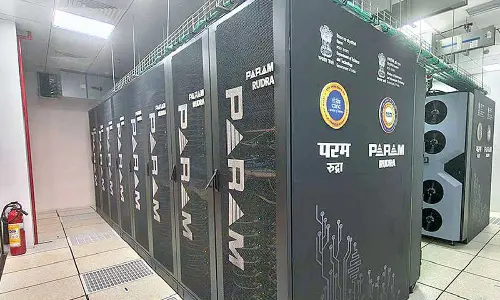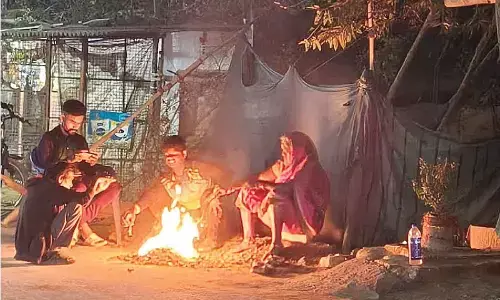Atmanirbhar BJP vs Regional Challengers

Atmanirbhar BJP vs Regional Challengers
Ambitions and political compulsions seem to have pushed the country into an election mode almost one year ahead of its time
Ambitions and political compulsions seem to have pushed the country into an election mode almost one year ahead of its time. This has come as a god-sent opportunity for political strategists who have pitched and would be making hay while the sun shines. The question is: can these regional parties push BJP out of power in next general elections?
The immediate need, as perceived by regional leaders, is to fight the BJP and prevent it from winning or increasing its strength in the poll-bound states. If regional challengers succeed in reducing the BJP strength, the way forward will become easier to mount a powerful challenge against Narendra Modi, his mastermind Amit Shah and the BJP organisation by the time the country goes in for Lok Sabha elections.
But this would be possible only if they have a unified policy (not common minimum programme keeping aside issues like J&K, power reforms and interlinking of rivers on which there is no consensus). Otherwise, we have seen in the past how such conglomeration of different colours and shades had collapsed like pack of cards.
The regional parties are nothing short of monarchs. There is nothing like participatory governance. Opposition is decimated, dissent is banned. Of course, even national parties are showing such trends now and then. But then there is a difference between the regional parties and established national parties, whether it be the Congress or the BJP. They have their own policy on issues such as foreign affairs, Defence matters and other contentious issues such as Article 370 which grants special status to J&K. No regional party has any clear stand on these issues. For example, when the Union government introduced the bill to abrogate Article 370, except JD-U, all NDA allies supported BJP on Kashmir provisions. BJP was also supported by parties like AAP, TRS, YSRCP, TDP and BSP. TMC and NCP walked out of Parliament amid Kashmir debate and Shiv Sena opposed it. The DMK felt it was murder of democracy.
Now after the TRS-BJP relations soured, the pink party says they have not taken any stand on Article 370. They feel that even after abrogation there has been no change in the ground situation as violence and terrorist activities were continuing. When the farm bills were introduced in the Parliament, AAP, TMC, DMK, TRS, Shiv Sena and Congress were among those who opposed it.
Let's look at the Rafale controversy. Congress, CPM alleged that there was huge corruption involved in it and that the BJP leaders got kickbacks. TMC wanted a transparent probe and it has become a never-ending tale. The TRS played a neutral game. Even during the last Parliament session when the Congress party created ruckus over Rafale, TRS MPs were seen protesting on the issue of paddy purchase. But now they have joined the bandwagon of Congress, alleging high corruption in the deal. What they are showing as proof are the clippings of allegations that are available on Google.
Let's take yet another issue: Linking of rivers. In 2017, the then Minister for Irrigation T Harish Rao suggested at a meeting on interlinking of Peninsular and Himalayan rivers organised by National Water Development Agency in New Delhi that the Centre first take up linking of Mahanadi-Godavari linking project. But today they seem to have made a volte-face saying that they were opposed to it. Tamil Nadu is in favour of interlinking of rivers. Chief Minister M K Stalin had in fact written letters to AP CM Y S Jagan Mohan Reddy and others seeking their support on the issue. But TMC, Congress party and Shiv Sena are opposed to such a move.
Similarly, power is among the most critical components of infrastructure, crucial for the economic growth and welfare of nations. The Indian power sector consists of the value chain which can be broadly segmented into generation, transmission, and distribution sectors.
The distribution sector consists of power distribution companies (Discoms) responsible for the supply and distribution of energy to the consumers of all sectors such as industry, commercial, agriculture and domestic. However, Discoms are struggling with high levels of losses and debt. They have failed to meet their payment obligations to power producers with dues of nearly Rs 700 billion (March 2021). The electricity Bill also proposes to help in handling issues like cross-subsidy losses, poor infrastructure, and losses. This will enhance the competitiveness of domestic industries in the power sector. The reforms under the Bill will provide financial relief to the states burdened by their Discoms' losses. The Bill is a critical step in the right direction considering India's international commitment to the use of renewable energy.
Still, as many as nine out of 29 state governments are opposing any reforms in the power sector as they feel that they fear it may delete the farmers from their vote bank account. They are cherry picking and want to continue with the existing system for sake of votes. Reforms would lead to privatisation of distribution, which means avoiding payments would not be possible. The state governments will have no administrative control over the power generators and distributors. Hence energy (power) has become a major issue to retain political power.
With so many divergent views held by each party, the big question now is can they come on one platform? Even if they succeed, will it just be a single point agenda of BJP 'Mukt Bharat'? Will they first come with a comprehensive action plan explaining the stand of the new political outfit on all the issues on which they differ? Can they arrive at a consensus on these issues or will they go in for 'confuse the voters if you cannot convince them'?
We have seen in the past what had happened to the conglomeration of different parties which had a common minimum agenda putting all contentious issues on the back burner. This proved to be hurdle to the government to move forward and finally they not only failed to deliver or show any difference in governance and they also simply collapsed, pushing the country back in terms of development when compared with many countries.
Another major issue is whether there can be two icons to lead the fight against BJP? KCR has taken 100% anti-BJP stand as of now and is projecting himself as the next 'Desh ki Neta (PM),' and his followers claim to have offered prayers at Medaram tribal fair. Some of his admirers had put up flexi boards in Varanasi, the constituency represented by Modi, and Gujarat, the home state of PM.
On the other hand, Stalin has already floated the All-India Federation of Social Justice; he invited even his political rival and AIADMK leader, O Panneerselvam. West Bengal Chief Minister Mamata Banerjee who is law unto herself has unilaterally asked Stalin to take the charge in coordinating with non-BJP CMs in the country as well as non-BJP political parties, including the Congress and the CPM. Though parties and leaders know about her maverick attitude, she is such a political force that no one can undermine or antagonise her.
Senior DMK leaders have started claiming that Stalin is an icon of Dravidian struggle and he has excellent rapport with almost all the national leaders. He has already commenced speaking to these leaders for a national platform against the BJP and after the urban local body polls are over on February 19, the momentum of this coordination will increase and a national platform against the BJP will soon emerge. So, first the issue of 'Icon' needs to be settled.
However, it is notable that so far there has been no formal or informal talks with the Congress leadership or the left parties on the anti-BJP league. The CPM leaders who met KCR expressed some serious reservations after the meeting.
While regional parties want power at Centre, the people in the country would look for a stable government. It could be BJP or Congress. In 1979 they voted overwhelmingly for a ramshackle election-eve coalition to take on Indira Gandhi's Emergency regime. When the new government collapsed quickly, they forgave the sins of the Emergency and voted her back to power. Similarly, since 2014 we saw how people stood behind BJP since they lost faith in Congress party. Hence, the next elections are going to generate a lot of interest for the political observers and analysts. The future of the country is at stake now. It is going to be another test for the people – stable government or another Khichidi Sarkar?










